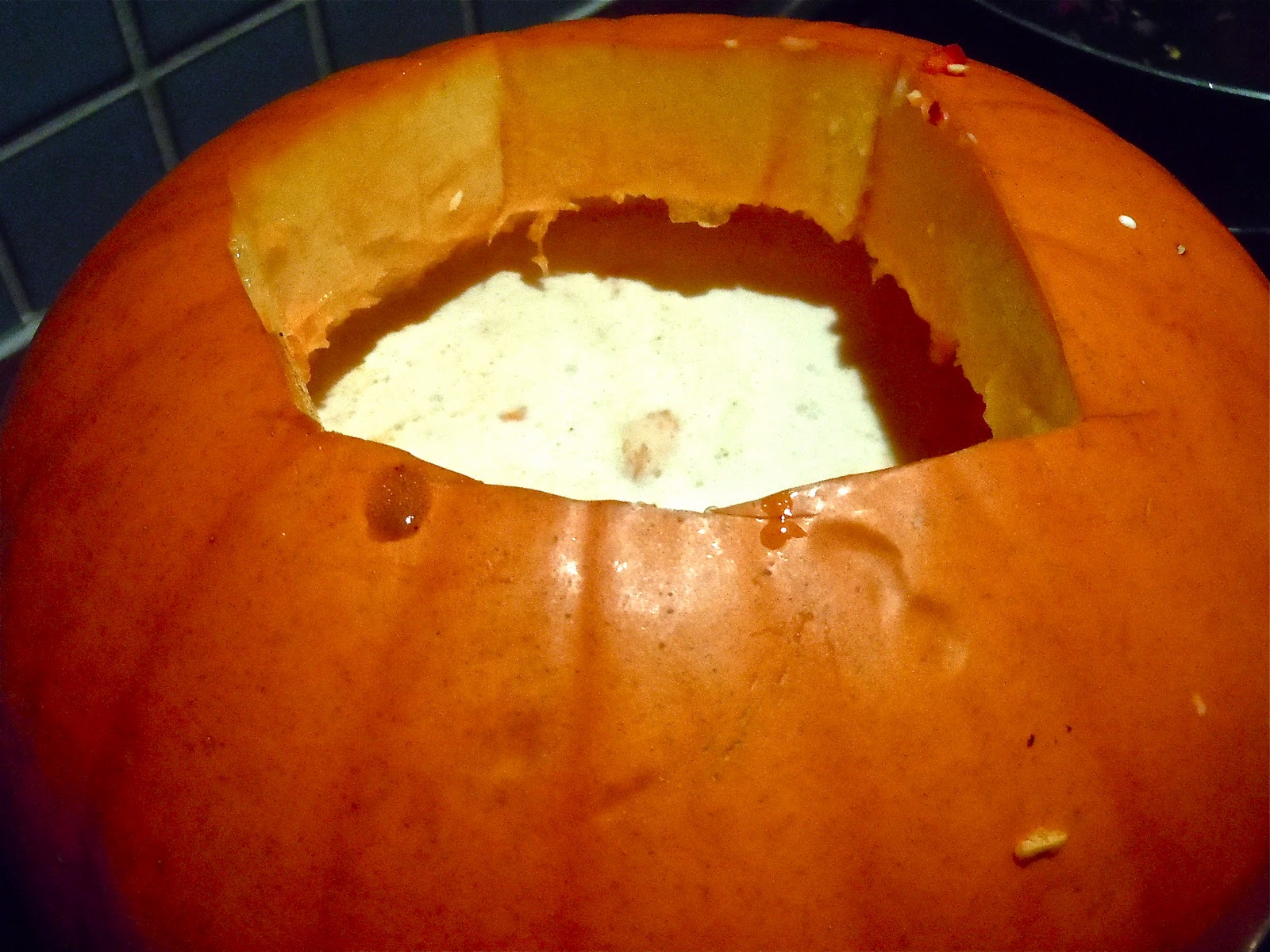A few weeks back it was Canadian Thanksgiving. Now, I'm all about the good ol' American way of celebrating (that is, in November), but there is rarely a time when I turn down good food. And, oh my, was this food good. Nay, glorious. The highlight of the evening had to be the cooked pumpkin soup. That's right, a soup cooked inside a pumpkin. A creamy buttery concoction that actually let you scrape the insides of the pumpkin with a ladle to get as much of that delicious sinewy goodness as you wanted for your bowl. Now if that isn't an "impress your guests" kind of moment, I don't know what is.
I spent the rest of the evening begging for the recipe. It turns out the recipe was from a "River Cottage" episode, a cooking show based in the UK. When I looked up the recipe online, I was almost bowled over by the fact that there were only three predominant ingredients in the entire soup: cream, Gruyere cheese, and, well, pumpkin. But the idea was so genius, I couldn't pass it up. I decided to tweak the idea just a bit, partially for my own health conscience (little as it may be) but more importantly to beef up the flavor a bit. So I added what I think is always a winning combination: coconut milk. By adding a little spiciness, some stock, and the coconut milk, it really fleshed out the flavor alongside the cheese and cream. I served it the week after Canadian Thanksgiving to rave reviews.
The only thing I will warn about is timing. It's hard to tell when the pumpkin is done, i.e. when the soup is warm enough to eat and the flesh of the pumpkin is cooked through. You also have to be wary of structural integrity issues. As the pumpkin cooks, it understandably becomes softer, which means your soup bowl may become a bit soggy and, if left unattended for long enough, collapse in the oven in a great pile of pumpkin-y goo. This is a bad thing. So, the only thing I can recommend is watching the pumpkin quite closely when you think you're getting close to being done.
Serves 4-6 generously
Ingredients
- 1 medium (3-4kg) pumpkin or several small squashes (1 per person)
- 4 stalks of lemongrass
- juice of one lime
- 2 x 50mm ginger, peeled
- 2 cloves of garlic, peeled
- 6 red chillies
- juice of 2 limes
- black pepper
- sea salt
- 2 tbsp vegetable oil
- 2 banana shallots finely chopped
- 5 g cumin seeds (or ground)
- 600 ml vegetable stock
- 400 ml tin coconut milk
- sprigs coriander/cilantro, to garnish
- Up to 500g Gruyere cheese, grated (depending on the size of your pumpkin)
- up to 400 ml of cream
- freshly grated nutmeg
- a knob of butter
- salt and freshly ground black pepper
Method
Preheat oven to 190°c/Gas Mark 5.
Slice the top off the pumpkin or squashes three-quarters of the way up and retain; this is your lid.
Scoop out all the seeds and surrounding fibres from the pumpkin.
Place the scooped-out pumpkin on a baking tray or in an ovenproof dish (which must have sides to catch any leaking cream - an accident that shouldn't, but can, happen).
Peel the outer coating from the lemon grass stalks and finely chop the white bulbous part of the stalks, discarding the rest.
Mix together the lemon grass, lime juice, ginger, garlic, chillies and lime juice into a smooth paste. Season with salt and freshly ground pepper.
Heat 1 tbsp oil in a heavy-based saucepan. Gently fry the shallots and cumin seeds for 3-5 minutes, then add in half the paste and fry, stirring often, for 5 minutes until fragrant.
Pour in the stock and bring to the boil. Reduce the heat and simmer for 7-8 minutes.
Put enough grated Gruyere into the empty cavity of the pumpkin to fill about a third of it, then pour in double cream and coconut milk until the cavity is two-thirds full.
Add a few gratings of nutmeg, a little salt and plenty of black pepper. Throw in a knob of butter and replace the lid, so the pumpkin is whole again.
 Place in a fairly hot oven (190°c/Gas Mark 5) and cook for 45 minutes-11/4 hours (for me, this was more on the 1 1/4 hours side of things), depending on the size of the pumpkin. Test for doneness by removing the lid and poking at the flesh from the inside. It should be nice and tender.
Place in a fairly hot oven (190°c/Gas Mark 5) and cook for 45 minutes-11/4 hours (for me, this was more on the 1 1/4 hours side of things), depending on the size of the pumpkin. Test for doneness by removing the lid and poking at the flesh from the inside. It should be nice and tender.
At this point, the skin may be lightly burnt and the whole thing just beginning to sag a bit. Be wary: when the pumpkin is completely soft and cooked through, there is a real danger of collapse.
The larger the pumpkin, the bigger the danger. Don't panic if it happens - it will look a bit deflated but will still taste delicious.
Serve small squashes individually in bowls, with spoons to scoop out the flesh. Serve the larger pumpkin by scooping plenty of flesh and the creamy, cheesy liquid (the Gruyere comes out in lovely long, messy strings) into warmed soup bowls. Either way, serve piping hot.

